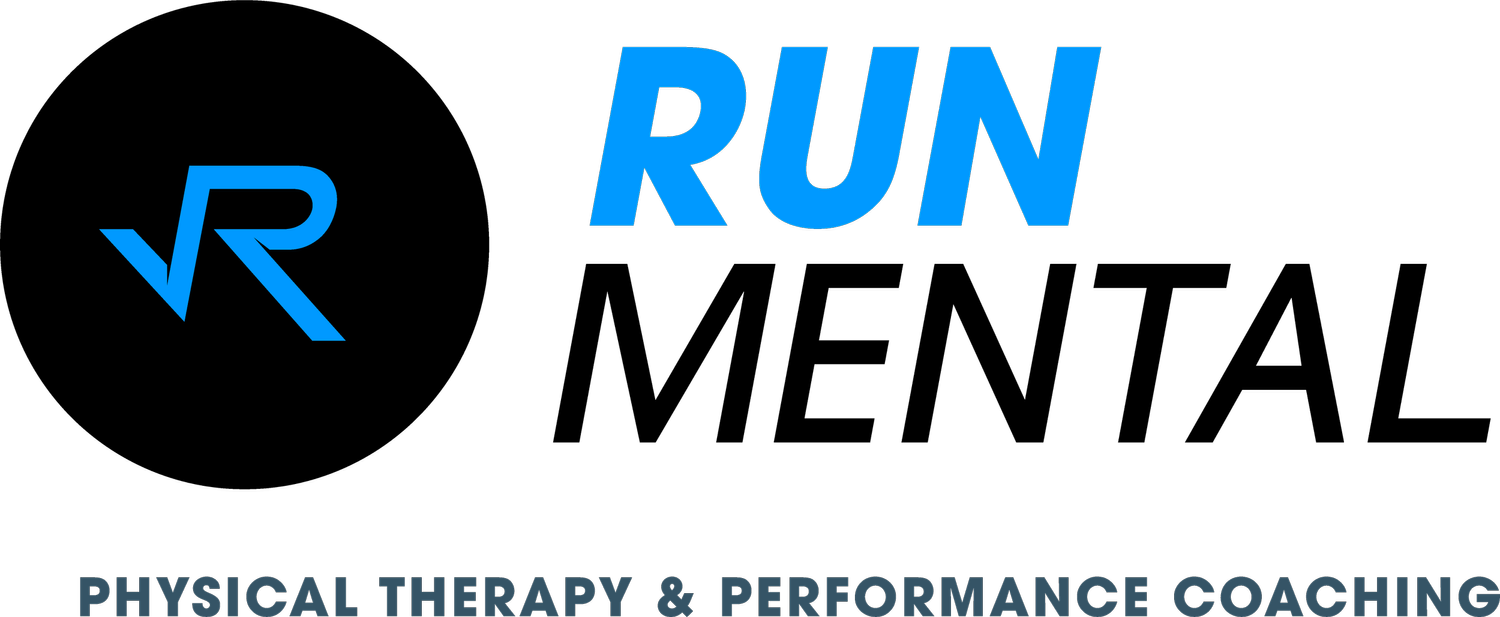The Master’s Runner
The Master’s Runner: Keys to Staying Injury Free and Running or Life
Participation in running events is exploding! Particularly at age 40 and over, there seem to be more people entering races. Unfortunately, a large amount of my case load as a physical therapist is within this demographic. Running is a predictable activity with predictable demands. Aging also entails some consistent characteristics that affect our performance. Knowing these, we can formulate a game plan to minimize the risk of injury and improve performance. What is extra convenient is that these strategies are very overlapping in nature.
Cardiovascular Changes That Occur With Age (Reference 1-4)
A loss of performance in running can be partially explained by a few changes in the cardiovascular system. Our maximum heart rate decreases by about 0.7 beats/min each year from age 20 to age 90. This limits the absolute intensity we can partake in by limiting the amount of blood pumped by the heart each minute, resulting in a decrease in oxygen to the muscles and extraction of metabolic waste.
Our Vo2 max also decreases as we age. Older runners have a decreased ability to extract oxygen from our blood and lungs, giving us less to utilize for our exercise demands. This factor combined with a decreased maximal heart rate results in an increase in rating of perceived exertion, making a given running speed feel harder than it once did, even with consistent training. With continued good training, that level of effort can remain similar, but it is due to maximizing other aspects of our physiology to allow better function.
As we get older life happens: we get jobs, have kids, and buy houses. Each of these undertakings requires a considerable amount of our attention, time, and energy. This often results in less time and energy to train and recover, leading in turn to a loss of positive adaptations from our younger selves. A decrease in volume and/or intensity of training are both important factors in sustaining our cardiovascular function.
It’s not all bad when we get older though! Running economy is generally defined as the rate of oxygen consumption at submaximal running speeds. This seems to be unaffected by the normal aging process. What a win considering how important that is in the road and track scene. Sorry ultra runners, but it’s not a saving grace for you since so many other variables can affect ultra performance. But it is still helpful to some extent.
Musculoskeletal Changes That Occur with Age (Reference 5-10)
The cardiovascular system is a huge driver in performance, but so is the musculoskeletal system. As we get older, the calf muscle complex (CMC) suffers a loss of strength and power. This is a critical hit as the CMC is the biggest work-horse in running, supporting 6-8x your body weight. Not only that, but it is the primary muscle group contributing to our propulsive forces and the primary contributor to the energetic cost of running.
Tendons are a runner’s best friend. When we run, the tendon acts like a spring that becomes tensioned due to muscle pre-activation prior to hitting the ground, so as to increase limb stiffness for more optimal function of the tendon. When the tendon recoils, it provides free energy to help support the high forces and energetic costs associated with running. This works best with stiff tendons, but as we age, there is a reduction in tendon stiffness and thus an increased need for the muscles to work, along with a decreased force output. Moreover, a decrease in tendon stiffness results in greater strain for the tendon, increasing the risk of injury. And there is no better way to interrupt good, consistent training than an injury.
The loss of strength and power in the CMC along with decreased tendon stiffness and thus less propulsive force all contribute to a decrease in stride length. To help maintain speed, many master runners seek to compensate with a higher cadence. The reduced stride length inevitably lowers the ceiling for how fast one can move. Preserving stride length through better function of the CMC and tendon function is not only good for performance, but also for injury risk reduction and overall longevity.
Addressing Age-Related Changes (Reference 11-14)
Is all hope lost once we approach our late 30’s and beyond? Hardly! There is no fountain of youth or magic exercise that can promise the world to you. Though exercise is our best option, as it facilitates faster rates of cellular turn over. All we can hope to do is to maintain our function as long as possible and then slow the decline as much as possible once it starts. At the time of me writing this, the best way I know how to achieve these goals are through heavy, slow resistance training, plyometrics and other rate of force development work, and higher-intensity intervals.
Some specific training decisions depend on the individual, but I do want to leave you with some practical applications you can start playing with. Heavy, slow resistance training options could look like heel raises with double and/or single leg variations. Generally, I recommend starting with a resistance that is roughly a 5-6/10 effort and working up to around 8/10 in the ensuing weeks. By “slow”, I mean a 2-3sec lengthening phase, followed by a 2-3sec shortening phase or vice versa depending on the exercise. Plyometrics could include jumping rope, box jumps, or many ladder drill variations. Plyometrics can become really intricate and advanced in the strength and conditioning world, but low level, simple ones will most likely do wonders for you.
While this claim hasn’t been specifically tested to my knowledge, masters runners who are well trained and continue to train with a comparable volume and intensity to younger runners retain CMC power and leg stiffness comparable to younger runners. Therefore, it seems likely that continuing to include higher-intensity work can protect against these age related changes. Workouts that include intervals in the window of 4min all the way down to 15sec would be suitable here. These would be done around a 5k effort or faster depending on the length of interval, length of recovery period, and number of repetitions.
As we age, the notable changes in our physiology result in a decrease in our ability to perform as runners as well as increases in our injury risk. Fortunately, these changes are predictable, giving us an advantage in fighting them off with the above-mentioned strategies.
If you feel that you need any help structuring your run training or strength work, please don’t hesitate to reach out to us or another trusted professional. You can connect with us via phone at (719) 270-3155 or email at runmental@gmail.com. We are also active on Instagram where we frequently post educational material about running rehab and training.
Happy running!
References
1. Tanaka H, Monahan KD, Seals DR. Age-predicted maximal heart rate revisited. J Am Coll Cardiol. 2001;37:153–156
2. Fuchi T, Iwaoka K, Higuchi M, et al. Cardiovascular changes associated with decreased aerobic capacity and aging in long- distance runners. Eur J Appl Physiol Occup Physiol. 1989;58: 884–889.
3. Quinn TJ, Manley MJ, Aziz J, et al. Aging and factors related to running economy. J Strength Cond Res. 2011;25:2971–2979.
4. Millet G., Hoffman M., Morin J. Sacrificing Ecomony to Improve Running Performance-A Reality in the Ultramarathon? J Appl Physiol 2012;113: 507–509.
5. P. Devita, R. Fellin. The Relationships between Age and Running Biomechanics. Med Sci Sports Exerc. 2016 Jan;48(1):98-106
6. T. Dorn, A. Schache, Pandy M. Muscular strategy shift in human running: dependence of running speed on hip and ankle muscle performance. J Exp Biol (2012) 215 (13): 2347
7. Hamner SR, Seth A, Delp SL. Muscle contributions to propulsion and support during running. J Biomech. 2010;43: 2709–2716.
8. T. Novacheck. The Biomechanics of Running. Gait Posture. 1998 Jan 1;7(1):77-95
9. Stenroth L, Peltonen J, Cronin NJ, et al. Age-related differences in Achilles tendon properties and triceps surae muscle architecture in vivo. J Appl Physiol. 2012;113:1537–1544.
10. Fukuchi RK, Duarte M. Comparison of three-dimensional lower extremity running kinematics of young adult and elderly runners. J Sports Sci. 2008;26:1447–1454.
11. Schoenfeld BJ, Ogborn D, Krieger JW. Dose-response relation- ship between weekly resistance training volume and increases in muscle mass: a systematic review and meta analysis. J Sports Sci. 2017;35:1073–1082
12. Lazarcsuk S., Maniar N., Opar D. Mechanical, Material and Morphological Adaptations of Healthy Lower Limb Tendons to Mechanical Loading: A Systematic Review and Meta‐Analysis. Sports Medicine 2022;52:2405–2429
13. Rønnestad BR, Mujika I. Optimizing strength training for running and cycling endurance performance: a review. Scand J Med Sci Sports. 2014;24:603–612.
14. Paquette MR, Devita P, Williams DSB III. Biomechanical implications of training volume and intensity in aging runners. Med Sci Sports Exerc. 2018;50:510–515.

